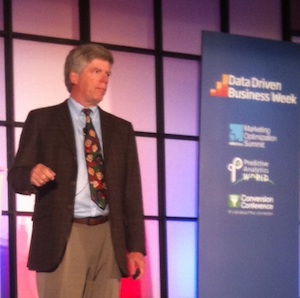Earlier this month, I attended eMetrics and Conversion Conference in San Francisco, part of a “data-driven business week” federation of related events. One of the highlights was a keynote by Tom Davenport — author of the bestseller Competing on Analytics — titled “The New Quantitative Era.”
Tom started with the observation that analytics teams are blossoming like flowers in Springtime throughout organizations. Web analytics, marketing analytics, HR analytics, supply chain analytics, predictive analytics, even actuarial analytics (the dismal science with a dashboard?). Collectively, these different beachheads combine into enterprise analytics.
He called it the “analytical equivalent of the European Union.” I’ll call it the United States of Analytics. It’s a loose affiliation of independent groups in the enterprise who are harnessing similar techniques to their different domains. They’re starting to connect to each other. And together, they share a common agenda: making better decisions in business based on data.
It’s not about the math
But this transformation shouldn’t be framed as data over human dynamics. To the contrary, the two should be entwined into a new culture of analytical leadership.
To illustrate this point, Tom quoted Karl Kempf — who has the title of Chief Mathematician at Intel and is an Intel Fellow — as saying: “If you want to be good about analytical decision-making, it’s not about the math.”
Yes, according to the Chief Mathematician, it’s not about the math, “It’s about the relationships.”
“The math person must understand the intuition and speak the language of the business person.” This is an asymmetrical relationship where the math person needs to have enormous respect for the business person, and the business person should have at least a little respect for the math person. The right models can help businesses compete, but models in the abstract have little value unto themselves.
A big part of capturing the value in analytics is being able to translate data into stories. “A lot of people can tell stories, a lot of people can work with data, but there aren’t too many at the intersection,” said Tom. “Without a story, you’re not going to influence a decision very much.”
New analytics: engineering + liberal arts
In Tom’s opinion, there are 4 skills that analytics professionals need to step up to the next level:
- The ability to tell a story with data.
- The ability to help frame decisions with data.
- The courage to stand firm when necessary.
- Don’t just identify problems in data — propose solutions!
Ideally, these skills should be applied in “agile analytics” — an approach, like agile development and agile marketing, that favors user-driven deliverables with frequent outputs and check-ins.
Tom sees this as essential to developing “a new analytical culture” that emphasizes:
- facts, evidence and analysis as central to the decision-making process
- a pervasive “test and learn” approach when there aren’t yet facts available
- a free pass for push-back — okay to question people, “where’s your data?”
- never resting on your analytical laurels — no model is a sacred cow
In surveying hundreds of corporate decision-makers, Tom found that the most common ways to “make better decisions” alternated between left-brain and right-brain techniques. Analytics was the #1 answer. But “changes in culture and leadership” was #2. Better data was #3. But “changes to process” and “better education” where #4 and #5 respectively.
“If your job is to make better decisions, you have to alternate between these two worlds.”
“A new model for analytics is emerging,” Tom said in closing. “There’s no better time to be in analytics. But it will require new management approaches and new ecosystems. This is not business as usual — this is a historic opportunity to transform your industry and function.”



